This site is still under construction in some areas. Please be patient with our glitches!
What exactly was the Decapolis? It was mentioned twice in Mark’s gospel and once in Matthew’s, but described only as a region near Galilee where Jesus’ fame spread. In The Gospel According to Yeshua’s Cat, Yeshua and Mari spend considerable time in the Decapolis among the Greco-Roman peoples there.
Decapolis meant literally “ten cities” in Greek, and referred to a loosely knit group of ancient cities in what is now Israel, Jordan, and Syria. No one can say for sure which cities were included in the ten–or even if there were exactly ten–since their relationship was never formalized in Greek or Roman law. As best we know, they were independent cities, each established as a polis, or city-state, with its own local sphere of influence. They supported each other because of their common ties of culture, similar economic interests, and commitment to the Greek, and later, Roman, empires. With the construction of Roman roads they became even more closely interconnected: outposts of the Roman Empire on its furthest eastern edges, islands of Greco-Roman speech and culture, determinedly set apart from the Aramaean, Nabataean, and Jewish populations all around them.

The red dots on the map above mark the eight cities closest to Galilee that were probably included in the Decapolis in the early 1st C. CE. The cities connected by red lines are the ones Yeshua visited in The Gospel According to Yeshua’s Cat, although (except for Scythopolis) they aren’t identified by name in the book. In the paragraphs below, cities where specific events in Yeshua’s Cat took place are identified by small cat silhouettes:
![]()
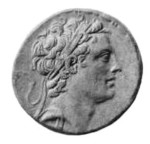
Greek influence in Syria was strongest between the time of Alexander the Great and the reign of the Seleucid emperor Antiochus IV Epiphanes, whose rule ended a century before the Roman conquest in 63 BCE. Most of the Decapolis cities were founded during this period.
When Antiochus Epiphanes desecrated the Temple and forbade the observance of the Jewish religion, Israel revolted, led by Mattathias the
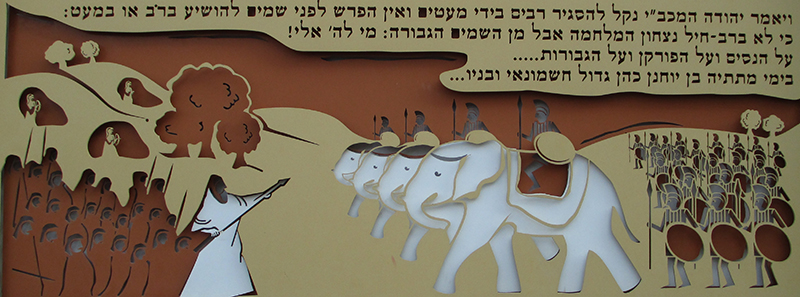
Hasmonean and his five sons, later known as the Maccabees. They overwhelmed the Seleucids and forced them to concede Israel’s limited independence, thus founding the Hasmonaean dynasty, which ruled in Israel until after the Roman conquest. Once the Greeks were defeated in Israel, the Hasmonaeans turned their eyes to the walled cities of Trans-Jordan, and conquered most of the Decapolis by the beginning of the 1st C BCE.
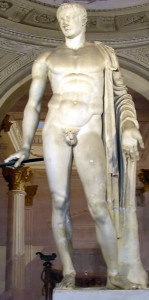
After annexing the Decapolis, the Hasmonaeans forced Judaism and circumcision on the predominantly gentile population of Hippos, exiled the gentiles from Scythopolis, and burned Pella to the ground after it refused to accept the Jewish religion. Circumcision was a point of irreconcilable conflict between Greeks and Jews. For the Jews it was the essential mark of the male believer in the One God; for Greeks it was a desecration of the divinely formed human body.
Hard feelings between the people of Israel and the Decapolis during the time of Jesus had roots both in the Seleucid oppression of Israel and the years of warfare under the Hasmonaeans. Each side had known cruelty and suffering. When Pompey claimed the Decapolis for Rome in 63 BCE, the gentile population greeted him as a liberator, and killed many Jewish residents in revenge for Hasmonaean cruelty. Once the Romans established themselves in the Decapolis, a period of extensive rebuilding began, lasting into the 2nd and 3rd centuries CE. As a result, little remains of the original Greek cities.
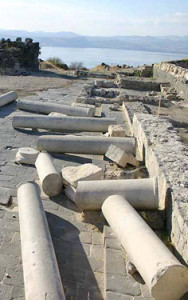
 HIPPOS sat on a high ridge overlooking the eastern side of Sea of Galilee, surrounded on all sides by steep inclines and high fortifications. One thin shoulder of rock approached the main gate on the east, where a fortified road connected the city to the eastern hills as well as indirectly to the sea. Of all the Decapolis cities, Hippos is said to have harbored the greatest antagonism toward Israel for her part in the Hasmonaean wars.
HIPPOS sat on a high ridge overlooking the eastern side of Sea of Galilee, surrounded on all sides by steep inclines and high fortifications. One thin shoulder of rock approached the main gate on the east, where a fortified road connected the city to the eastern hills as well as indirectly to the sea. Of all the Decapolis cities, Hippos is said to have harbored the greatest antagonism toward Israel for her part in the Hasmonaean wars.
![]() As you read of the blind man Yeshua healed outside the gates of the first Decapolis city he visited, you can imagine that long ridge by which travelers still approach the gates of Hippos.
As you read of the blind man Yeshua healed outside the gates of the first Decapolis city he visited, you can imagine that long ridge by which travelers still approach the gates of Hippos.

![]()
 GADARA, like Hippos, was built on a long ridge with steeply sloping sides. Unlike the other Decapolis cities, Gadara developed an international reputation for philosophy, art, and literature. Pilgrims to the hot springs located below the city also contributed to its cosmopolitan atmosphere. Some scholars believe that the story of the demoniac among the tombs was set in its general locale.
GADARA, like Hippos, was built on a long ridge with steeply sloping sides. Unlike the other Decapolis cities, Gadara developed an international reputation for philosophy, art, and literature. Pilgrims to the hot springs located below the city also contributed to its cosmopolitan atmosphere. Some scholars believe that the story of the demoniac among the tombs was set in its general locale.
![]() Yeshua’s debate with the young philosopher took place in a wealthy home in Gadara.
Yeshua’s debate with the young philosopher took place in a wealthy home in Gadara.
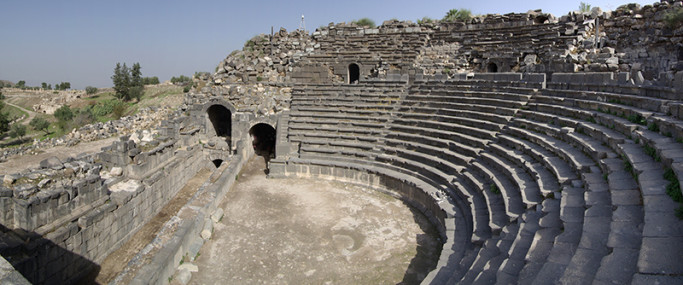
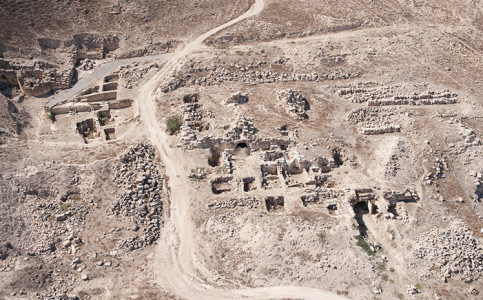
ABILA is still little more than an excavation in process, with only tantalizing possibilities visible to the visitor. But the area awaiting excavation is immense. The ruins extend across two tells, and appear to include structures going back as far as 4000 BCE.
![]()
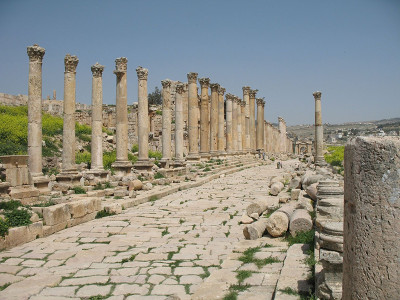
GERASA, or JARASH, was a strong walled city, but stood in a river valley rather than on a hill. Most of the surviving structures date back to a massive Roman building program begun in the 1st C CE. The Cardo, or main thoroughfare, is one of oldest structures, running east-west through the city, with the marketplace on its west side.
Below are the remains of the market, or macellum, where Yeshua’s parable of the prodigal son brought a tide of change to the people of the Decapolis. This was also the market where Mari trapped Maryam into speaking with Yeshua.
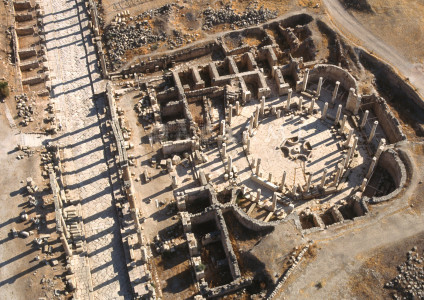
PELLA, of all the ancient cities of the Decapolis, has left the greatest mystery behind. Almost no ruins from the Roman period have survived. Located in the hills on the east side of the Jordan Valley, on a major Roman road, Pella lay in an area with fertile soil and plentiful water, where towns had stood almost continuously from Neolithic times. After Alexander Jannaeus sacked and leveled the city in 82 BCE, it was entirely rebuilt by the Romans. Archaeologists have suggested that after the great earthquake of 526, the inhabitants of Pella might have recycled the rubble of Roman buildings to rebuild the city.

![]() SCYTHOPOLIS, or BEIT SHE’AN, is the only one of the Decapolis cities located on the western side of the Sea of Galilee. These ruins have been extensively excavated, revealing almost continuous occupation from the earliest times, although the city’s significance fluctuated with intermittent wars and violent conquest. The Seleucids founded Scythopolis in the 3rd C BCE on the ruins of the ancient city of Beit She’an, destroyed during the Assyrian sack of Israel. During the Hasmonaean wars much of the Greek polis was destroyed. Once the Romans took over, Scythopolis was named the capital of the Decapolis, and a massive urban building program began, which continued through the next 2-300 years. The steep hill, or tell, which rises to the north of today’s excavated Roman city, covers the remains of the biblical Beit She’an, as well as Seleucid and early Roman ruins. Most of the monumental Roman buildings were completed during the 2nd and 3rd centuries CE on the flat land to the south and east of the tell, leaving little evidence of the city’s appearance during the time of Jesus, although the main layout of the streets may have been similar.
SCYTHOPOLIS, or BEIT SHE’AN, is the only one of the Decapolis cities located on the western side of the Sea of Galilee. These ruins have been extensively excavated, revealing almost continuous occupation from the earliest times, although the city’s significance fluctuated with intermittent wars and violent conquest. The Seleucids founded Scythopolis in the 3rd C BCE on the ruins of the ancient city of Beit She’an, destroyed during the Assyrian sack of Israel. During the Hasmonaean wars much of the Greek polis was destroyed. Once the Romans took over, Scythopolis was named the capital of the Decapolis, and a massive urban building program began, which continued through the next 2-300 years. The steep hill, or tell, which rises to the north of today’s excavated Roman city, covers the remains of the biblical Beit She’an, as well as Seleucid and early Roman ruins. Most of the monumental Roman buildings were completed during the 2nd and 3rd centuries CE on the flat land to the south and east of the tell, leaving little evidence of the city’s appearance during the time of Jesus, although the main layout of the streets may have been similar.

Temples were built on the tell at various times during Greek and Roman occupation, perhaps partly because of Scythopolis’ fame as a major center for the worship of Dionysos. Legends of the time located the tomb of his nurse Nysa at Scythopolis.
![]() Because of the city’s connection to the Greco-Roman dying and rising agricultural god, in Yeshua’s Cat the procession of Tammuz’ devotees witnessed by Mari, Yeshua, and the disciples took place in Scythopolis. The tell was the hill the mourning women climbed by torchlight.
Because of the city’s connection to the Greco-Roman dying and rising agricultural god, in Yeshua’s Cat the procession of Tammuz’ devotees witnessed by Mari, Yeshua, and the disciples took place in Scythopolis. The tell was the hill the mourning women climbed by torchlight.

.
.

How did the cat in Yeshua’s Cat come to be?
I’d like to say that Mari emerged fully grown from my brow, like Athena from the brow of Zeus, but it didn’t happen that way. She grew slowly as I wrote, born from the personality of the small black cat under the fir tree in the photo, maturing and growing as the book grew, and I with it. She was the author of the book as much as I.

While I was writing Yeshua’s Cat, I was also lending a hand with my sister-in-law Wendy’s Ragdoll cattery. So not only did I have my three rescue cats dancing in and out of my thoughts and over my computer keys, but I also entertained rolling tides of soft-furred queens, kings, princes and princesses, rising and tumbling over the threshold of my room with the rhythms of the day. (They’re gorgeous, by the way: Treasure Mountain Ragdolls).
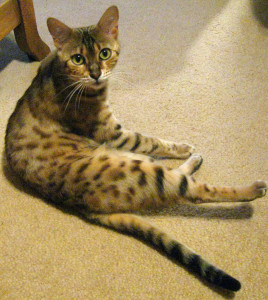
And then there was Chami, the elegant Bengal queen who moved in with me for several weeks while she was between homes. Beautiful and sweet-tempered though she was, she left me feeling as if living with her was a bit like inviting a panther into my bed. I slept lightly in her presence. I suppose the movie Cat Woman deserves mention as well, disappointing as it was. It did send me googling off for more data on the Egyptian Mau. Before seeing the movie, I knew little more than rumors of the breed. Afterwards I was curious enough to want to discover how much of the movie’s hype had been based in fact.

What conclusions I drew about the relationships between the movie and the Mau I no longer remember, but I did stumble onto one amazing thing: the Egyptian Mau cats in the photos looked like the Mari in my mind. I had finished the book by the time I made this discovery, but that made no difference to the identification. Mari was darker than most Egyptian Mau, more like a black or smoke Mau, but her build, her markings, and her face were all theirs–not to mention her affectionate nature, her devotion to her human, her protectiveness, and her hunting skills. So her breed was established, at least in my mind.
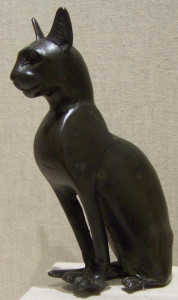
Since Yeshua discovered Mari on the edges of the barren desert surrounding the Dead Sea, I decided that her feline family might have arrived in the area by way of the Nabataean caravans traveling up from Sinai. Or perhaps they were wandering strays from one of the Nabataean cities to the south, or even escapees from a passing camel train. The Nabataeans had originally been tent-dwelling desert shepherds and traders, a mysterious group related to the Bedouin who amassed great wealth over several centuries from their trading networks, and eventually settled down in desert cities. Rock-cut Petra is their most famous settlement, although they also built cities further west and south along the ancient spice routes.
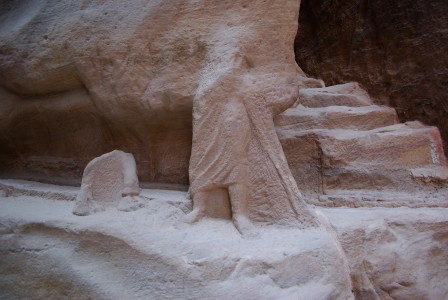

As far as research can tell us, people of 1st C Israel did not keep pets–even dogs–although there was some limited cooperation between the two species. Perhaps the absence of pets was due to Israel’s concern for ritual purity, particularly relating to the ritual uncleanness of scavengers and predators. In any case, their attitude toward animals seemed largely functional. The prophet Ezekiel singled out Bubastis, city of the temple of the cat goddess Bastet, as one of the cities upon which God would pour out his wrath (Ezek 30:17). His mention of this city suggests that the cat goddess was familiar to the people of Israel. She might even have inspired dislike of cats in general. Wealthy Greeks and Romans, however, frequently kept pets, ranging from snakes, monkeys, and fowl to their favorite pet, the dog. But outside of Egypt cats weren’t often accepted as companions until the Common Era.
Cats almost certainly lived on the fringes of Israelite society, even though they may not have been welcomed into people’s homes. By the 1st C C.E., cats had been semi-domesticated throughout the eastern Mediterranean area for several thousand years. Wherever grain was cultivated, rodent control was essential, and cats filled that ecological niche efficiently. They would have been a long-established part of Israel’s environment.
![]()
For Yeshua to have kept company with a cat would certainly have been seen as aberrant behavior, even religiously questionable. But he had his own ways of dealing with such things.
.
.